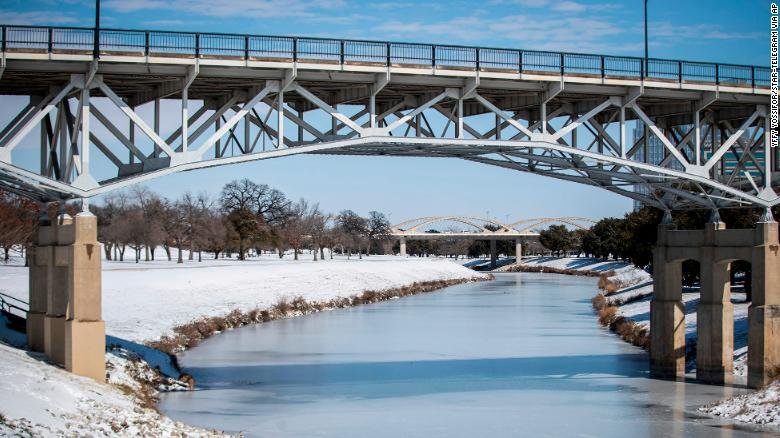After the snow melts, the flooding will begin

Here's how to prepare
You're probably familiar with the dangers that snow and ice pose for motorists. But how about your home?
More than 73% of the United States mainland was covered by snow last week, according to the National Oceanic and Atmospheric Administration's Office of Water Prediction.
Soon, warmer temperatures will thaw that snow and ice, creating snowmelt runoff and increasing the risk for leaks and floods.
Unprepared homeowners, especially those in the South, where snowstorms aren't common, face the prospect of widespread damage and costly repairs.
Here are five steps you can take to limit the damage.
Check the forecast
Sudden temperature swings can cause snow to melt quickly, increasing the risk for snowmelt runoff and floods. Pay attention to the forecast to get a sense of how fast you'll need to act to prevent water damage.
Homeowners who live near rivers and lakes may need to move faster than others. That's because cold temperatures often create ice jams, which occur when pieces of floating ice build up and block the flow of water.
"The main concern with ice jams is flooding," said CNN Meteorologist Jennifer Gray. "The most common places for ice jams are usually near bridges and sharp turns in rivers. When large chunks of ice flow up against a bridge, that bridge acts like a dam causing the water to back up behind it."
The risk doesn't necessarily decrease when the ice begins to melt. In fact, it could cause more water to spill over and contribute to flooding.
To limit the damage caused by snowmelt runoff and flooding, Erie Insurance advises homeowners to "hit the street" with their shovels, clearing nearby storm sewers of debris and snow.
Move snow away from your home
Before the melting starts, you should move snow away from your home.
One cubic foot of compacted snow holds between two to three gallons of water, according to North Dakota State University. Once that snow melts, it soaks everything in its path.
NDSU advises homeowners to move snow a few feet away from their homes so that water doesn't drip along basement walls, seep inside and cause damage.
Moving snow off the roof before temperatures rise can also help prevent serious leaks. A 1,000 square foot roof covered in one foot of snow holds 2,500 gallons of water, NDSU said.
Check your gutters. Even if they're clean, water can turn to ice and cause blockage, leading to large and small pools of water.
And don't forget to clear the small spaces -- digging snow out from window wells, doors and exterior stairwells, Bieritz Insurance Agency advises. "As little as 6 inches of melting snow and ice can lead to flooding," the insurance company in Cooperstown, New York, says on its website.
Test your flood defense
A sump pump, which pumps excess water out of basements via a discharge line, can be installed at the lowest point in your house to prevent it from flooding.
If you have one, conduct this simple test to see if it works: Pour water into the well around the pump, which should raise the float and start the motor. If it starts and you see the water you poured into the well start to drain out, your home should be protected in the case of flooding.
Some sump pumps are water powered, while others work on electricity. If yours is the latter, make sure to install a secondary power source, such as a backup battery or generator.
SEC America Corp, which sells backup batteries, explains: "Battery backups for sump pumps ensure that even if utility power is not available because of a power outage, your pump will continue functioning. Because most sump pump failures are electrical and not mechanical, installing a battery backup system is one of the most effective ways to avoid pump failure."
Turn off the water
Cold temperatures can cause water pipes to freeze, crack or burst.
"Frozen pipes are one of the leading sources of property damage when the temperature drops," says the Insurance Institute for Business & Home Safety.
Hopefully you took precautions to protect your pipes from freezing before the winter storms. Common methods include insulating pipes and raising your home's thermostat, according to the IBHS.
If your pipes did freeze, you'll know because faucets will sputter or stop providing water altogether.
Because frozen pipes often lead to cracked ones, you should turn off the water before the ice melts. This way, water doesn't leak inside your home and cause expensive damage.
Next, call a plumbing service for help. They can thaw your pipes, check for cracks and make repairs before the problem gets too big.
Dry your home
Sometimes, no matter how hard you try, snowmelt runoff will still leak into your home.
If that happens, you'll need to act fast. "Dry any wet building materials or items like carpeting, furniture, insulation and drywall to avoid mold, mildew and further damage," Erie Insurance says.
The longer you wait, the worse the damage will be -- likely increasing the cost of repair.
You should also document the incident, taking photos and videos of the damage before and after you address them. This way, if you report it to an insurance company, you'll have the evidence needed to support your claim.